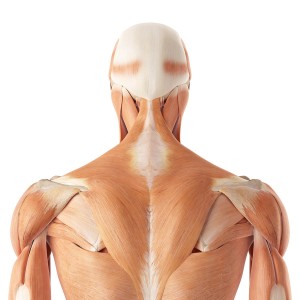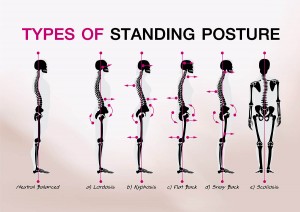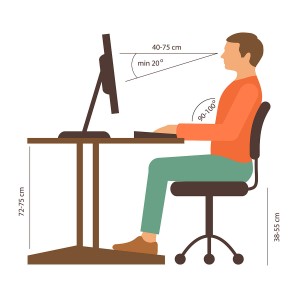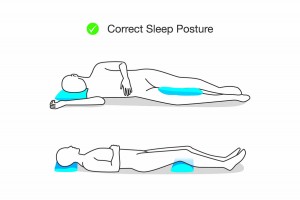 Good posture should align your body so that minimal stress is placed on joints and the supporting muscles, tendons, and ligaments. This results in the stresses of daily life being distributed evenly.
Good posture should align your body so that minimal stress is placed on joints and the supporting muscles, tendons, and ligaments. This results in the stresses of daily life being distributed evenly.
Good posture also allows you to facilitate movement as efficiently as possible, which decreases the stress on your joints, increases your overall performance, and allows for optimal function of your internal organs and nervous system.
Maintaining optimal positioning at all times is, unfortunately, simply not possible. Your body is designed to bend, extend, and rotate, to move into different positions for different tasks. The problem comes when you spend so much time in a single position, that you no longer return to optimal posture once the task is complete.
We have all experienced the negative effects of staying in a static position for too long. To stay pain free, you should maintain a dynamic posture where regular movement occurs.
Movement is vital for your health. However, repeated bending and twisting of your spine, even when unloaded, is not ideal and can lead to issues such as chronic back pain. Movement should predominantly stem from your limbs. Your shoulders and hips are ball-and-socket joints that are designed for a wide variety of movement.
Below, I set out my guidelines for good posture. Posture is affected by body type and shape, and these guidelines will help you find what is right for you. Ideally, it will be a position within an optimal range that accommodates your own lifestyle and anatomical structure.
When an individual favours certain muscle groups to achieve an action, it may result in some slight postural deviations. For example, if your job involves repetitive actions, or requires you to be in the same position for prolonged periods, your body will adapt to better facilitate this.
Standing Posture
The standing position is the position in which posture is usually assessed. If I tell an individual I am going to assess their posture, they will quickly pull their head up, their shoulders back, and their stomach in, resulting in an unrealistic assessment. To counter this, I have clients jog on the spot, prior to me abruptly telling them to ‘stop’. From there I can see the position that their body naturally falls into.
While standing, the optimal position is to have your feet roughly hip-shoulder width apart, with your knees and hips centred over the middle of your feet halfway between your toes and heels (midfoot).
Your knees should be slightly bent, (often referred to as having ‘soft knees’). This allows the musculature of your legs to help support the surrounding structures while reducing stress on your knees and lower back. Maintaining a soft knee position also allows for better circulation through the legs.
Your torso should be balanced over your hips, not leaning forward or back. Your shoulders should be held back and down, with your chest pushed out and your chin held up and back. This allows your ears to sit directly over the centre of your shoulders, which should in turn align vertically with your hips, knees, and midfoot.
Your arms should be held in a controlled manner at your side, once again allowing the musculature to support the surrounding structures.
A great cue for maintaining good posture while standing or walking, is to imagine you are trying to look over a fence that is an inch too high, without going up onto your toes. This will naturally cause you to push your chest out, while retracting your chin and pulling your shoulders back.
Sitting Posture
When sitting without any back support, your torso should be positioned over your hips.
Your shoulders should be pulled back and down, and your chin should be up and back. This results in your ears falling in line with the centre of your shoulders and hips, just like in a standing position.
The height of your seat should allow your upper legs to rest parallel to the ground, or slope towards the floor. You don’t want your knees higher than your hips. This restricts the circulation through your legs and holds your hip flexor muscles in a shortened position, potentially leading to postural issues and lower back pain.
Regular movement is the key to soft tissue health, so your foot position should be comfortable, but changed regularly.
If you are leaning forward slightly it’s fine to tuck your feet under the chair, but if you are leaning back on a chair rest, then your feet should be flat on the floor in front of you. If your feet dangle off the chair it will pull your pelvis into an anterior tilt (forward tilt) and result in your core musculature having to compensate.
Spreading your feet out to the front on your heels, will encourage you to slouch. Crossing your legs should also be avoided as it will result in one hip sitting higher than the other. This limits circulation and places extra strain on your spine.
When sitting on a chair with a back rest, the same postural cues should be taken. However, it’s important to ensure that you push your bum to the rear of the chair prior to sitting up, which prevents you from slouching.
Remember, prolonged sitting, regardless of how well you are positioned, can potentially cause issues.
Lying Posture
When lying or sleeping, it all comes down to what is comfortable for you. Yes, there are certain sleeping positions which are advised against, such as sleeping on your stomach, as they generally result in poor alignment of your spine and can potentially restrict breathing.
However, if that’s the position you’ve slept in since childhood with no problems, then the likelihood of it changing is slim.
Pillows can be used to help achieve a more supported sleeping position:
· Use a pillow that keeps the cervical spine (neck) in a neutral position
· Back lying – Placing a pillow under your knees will take the stress off your knee joints and your lower back.
· Side lying – Placing a pillow between your legs can help to keep your spine in good alignment.
· Side lying – Hugging a pillow to the front can help to maintain a comfortable position for your shoulders.
· Side lying – A pillow placed behind you can be used to lean back on, which will help to take pressure off your shoulders.
· Stomach sleeping – A long pillow can be used to raise one arm and one leg. This puts you into a more diagonal sleeping position, helping to keep your spine in good alignment.
In the morning, remember that your intervertebral discs (the fluid filled sacks that act as shock absorbers between each vertebra) are at the greatest risk of injury when you first get up.
When you are lying down, gravity does not compress your spine as it does when you are standing, so the amount of fluid within the discs increases. This in turn increases the pressure placed through them when you flex your spine.
To avoid damaging these discs, you should use a controlled roll to one side to get out of bed, rather than the more aggressive ‘sit up’ action that is commonly used, especially when late for work!
This increase of disc size is the reason why you are slightly taller in the morning, and why it is highly recommended that you mobilise your spine, especially if you are undertaking any resistance training in the morning.
Thanks for reading
Jay



